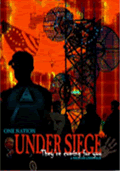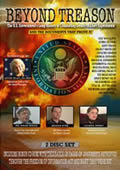Other
Stuter
Articles:
Justice For All
Or Justice Fon
None
System
Governance Bankrupting
States
Are Public
Schools
Constitutional
Homeschools, Private Schools,
and Systems Education
By Lynn Stuter
June 20, 2006
NewsWithViews.com
As chaos and violence become more frequent in America, the result of the humanist philosophy undergirding political, government and social institutions, people are coming more and more into contact with law enforcement which people errantly believe, in the face of the quiet transformation of America to systems governance, is there for their best interests and in the interests of law and order.
What follows is this researcher�s journey through what should have been a relatively simple event. As shall be seen, what should have been and what was are diametrically opposed.
On December 31, 2005, perpetrator or perpetrators unknown entered upon our property through closed gates, removed our flag from our floodlit flagpole approximately 50 feet from our front door, took that flag to another location not far distant and desecrated it by pouring house paint all over it. The flag was left laying in a heap in the middle of a roadway surrounded by one gallon paint buckets, most still containing paint.
Law enforcement was called. In this case, law enforcement constitutes the Stevens County Sheriff�s Office in Washington State. It is imperative to point out, at this juncture, that the Stevens County Sheriff�s Office is not representative of every law enforcement agency in the United States. This is the same Sheriff�s Office whose officer, illegally in possession of an Austrian made Steyr machine gun, shot up the neighborhood with that gun during a party where he and his guests had consumed alcohol. This is the same Sheriff�s Office that took no action when officers got drunk and disorderly at a bar then drove their private vehicles home. Arriving on scene, the opening salvo of the responding officer in charge was to rudely and unprofessionally address me as �Stuter.� His conduct, as we shall see, was but a precursor of events to come. Although clearly stated in the Sheriff�s Office policy manual that such conduct will not be tolerated, a complaint filed concerning his rude and unprofessional conduct was returned �unfounded� which came as no surprise given the history of unprofessionalism exercised by this particular Sheriff�s Office.
On scene that night, the responding officer in charge allowed evidence in the desecrating of the flag out of his custody, resulting in the evidence no longer being credible to any investigation that might ensue; essentially the officer destroyed evidence. That evidence consisted of five one-gallon paint buckets, complete with lids, stolen from a property near where the flag had been desecrated and left laying in the road. The responding officer in charge allowed these paint buckets to be removed from his custody after declaring loudly to everyone within hearing distance that he couldn�t find any fingerprints on them. This proclamation coalesced his observing me approaching where he was when I observed the paint buckets being removed from the scene. The time he supposedly spent attempting to fingerprint the buckets from the impromptu �lab� set up in the trunk of his patrol unit did not lend to a credible or competent job. Given that the lids were pried from the paint buckets, given that this was obviously a crime of opportunity, the likelihood of the paint buckets being devoid of viable fingerprints was minimal to nonexistent.
Allowing the evidence out of his custody destroyed any evidentiary value the buckets might have provided in a more competent laboratory setting with properly trained, competent forensic personnel. The fact that he did this was not stated in his police incident report, nor was the name of the individuals to whom he released the paint buckets in his police incident report.
After performing a fingerprinting job that was less than credible, less than competent, after releasing evidence out of his custody, it was amazing to listen to the responding officer in charge then expound vociferously on who he suspected the perpetrators were � three individuals whom he had no problem naming and defaming before all present. In one breath he expounded on how he wished someone would �catch these guys;� in the next he warned that anyone confronting them should be careful as they might be armed. Not once did it seem to occur to the responding officer in charge that catching the perpetrators was his job, his very statement showing a lack of professionalism and training.
The names of the three showed up in the police incident report he filed; but interestingly, how he came to a credible conclusion that these three were involved was decidedly absent. Since no one present at the scene saw the three before, during, or after the incident; since no credible investigation appeared to be under way, or would be under way, evidenced by the officer in charge allowing evidence out of his custody; the �race to conclusion� in the naming of these three as suspects raised red flags.
Beyond his initial addressing me in rude and unprofessional manner, I never spoke to the responding officer in charge or he to me. Nor did I address anyone else in his presence or hearing range at any time. Imagine my surprise then, when the responding officer in charge implied, in the police incident report he wrote and filed, that he had overheard a conversation between me and a neighbor, the content of which he relayed as fact in the report. The conversation never occurred which means the responding officer in charge deliberately falsified the police report. Under Washington code such constitutes a gross misdemeanor.
The responding officer in charge also stated, in the above referenced falsified statement he made, that the flag had been �lowered� off our flagpole. Since he never entered onto our property that night, did not inspect the flagpole or halyard assembly for raising and lowering the flag, nor the ground around the flagpole; since there was no further communication between he and I following his initial rude and unprofessional behavior; since I, at that time, did not know whether the flag had been lowered or cut from the flagpole; how he came by the knowledge that the flag had been lowered rather than cut from the pole raised more red flags. Coupled with allowing evidence out of his custody that could point to the actual perpetrators suggests that the actual perpetrators and those he named as suspects weren�t the same; that he knew they weren�t the same; that he deliberately destroyed evidence that would prove they weren�t the same.
In the week following the incident all documents concerning the incident were requested from the Stevens County Sheriff�s Office. Getting those documents proved to be a daunting task with the Stevens County Sheriff�s Office leaving no ruse fallow to try and keep information from us, even though such clearly violates the Washington State Public Disclosure Act.
What became obvious, however, was that documents that should have been with the police incident report, if a credible investigation was really the focus and goal, were not; information that should have been in the police incident report, if a credible investigation was the focus and goal, was not; the police incident report was falsified.
A request for a copy of all verbal communications recorded by the Emergency Dispatch Center regarding the incident resulted in an audio recording that was taped then re-taped, suggesting that such was done to erase verbal communications regarding the incident that pointed to misconduct and unprofessional conduct by personnel of the Stevens County Sheriff�s Office. That tape was received six weeks after the initial request for disclosure was made, again clearly in violation of the Washington State Public Disclosure Act. Beyond this, although the initial request for disclosure requested the tape be certified as a true and exacting copy of all communications, what was received gave the appearance of being certified but was not. Although the Sheriff of Stevens County was made aware of this, no corrective action was forthcoming.
But events didn�t end there. Things just kept getting better and better.
Irrespective of all that should have been with the police incident report and was not, the falsified information in the police report, the release of evidence out of police custody, all brought to the attention of the elected Stevens County Sheriff, this incident was referred to the detective branch of the Stevens County Sheriff�s Office. That�s right � irrespective of all that should have been with the police incident report and was not, the falsified information in the police report, the release of evidence out of police custody, all brought to the attention of the elected Stevens County Sheriff, this incident was referred to the detective branch of the Stevens County Sheriff�s Office. Why raised more red flags.
In early February 2006 an individual identifying himself as a detective with the Stevens County Sheriff�s Office called my home. He wasn�t too sure whom he was calling, couldn�t get the name right, didn�t have his facts straight, apparently couldn�t read the computer generated police incident report filed, was generally uninformed and seemingly confused. Whether putting on an act or really that incompetent, his routine instantaneously raised more red flags.
Given the red flags already raised, when the detective wanted to ask some questions, I told him I would have to record our conversation. That he didn�t like that idea and wouldn�t consent to being recorded raised more red flags. After all, if his wanting to ask some questions was straight forward in purpose and intent, why would he have a problem with the conversation being recorded? I refused to speak with him unless I recorded the conversation and he hung up.
Looking at the 1) falsified police incident report, 2) destruction of evidence by releasing it from custody, 3) the naming of suspects with no credible investigation having been conducted and in light of destruction of evidence, and 4) the missing documents from the police incident report, all coupled with the 1) zeal to address the incident despite all this, and 2) the refusal of the detective to have our conversation recorded, more than suggests that the Stevens County Sheriff�s Office had ulterior motives that were thwarted when I refused to speak with the detective unless I recorded the conversation.
|
Subscribe to the NewsWithViews Daily News Alerts! |
People want to believe that law enforcement is there for their protection; that law enforcement officers are honest, upright citizens who take their job to �protect and serve� seriously. Such, as more than adequately demonstrated here, is not necessarily true. In the changing mission of law enforcement under systems governance, what is and what should be are diametrically opposed.
� 2006 Lynn M. Stuter - All Rights Reserved
Sign
Up For Free E-Mail Alerts
Mother and wife, Stuter has spent the past ten years researching systems theory with a particular emphasis on education. She home schooled two daughters, now grown and on their own. She has worked with legislators, both state and federal, on issues pertaining to systems governance and education reform. She networks nationwide with other researchers and citizens concerned with the transformation of our nation. She has traveled the United States and lived overseas.
Web site: www.learn-usa.com
E-Mail: lmstuter@learn-usa.com�
That�s right � irrespective of all that should have been with the police incident report and was not, the falsified information in the police report, the release of evidence out of police custody, all brought to the attention of the elected Stevens County Sheriff...














